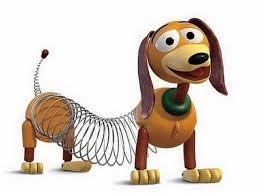THE FALL OF A SLINKY!!!

It maybe a very easy concept. But, i felt it quite interesting...So everyone, please attempt this question and give it your best...LOL!! I hope the pic adds some humor to it...;P
I'm on the top of a 15 meter tall tower and i extend a slinky (really long) from it at an appreciable distance above the ground. I let go of the tip of the slinky that was in my hand and let it drop under the action of gravity. My question is :What will happen to the other end of slinky that was hanging down?
Will it fall down as soon as i let the other end go?
OR
Will it wait for the other end of the slinky?
OR
Will it move upward towards the other end of the slinky??
Please reason your arguments and thoughts...thnq:)
No vote yet
1 vote
Easy Math Editor
This discussion board is a place to discuss our Daily Challenges and the math and science related to those challenges. Explanations are more than just a solution — they should explain the steps and thinking strategies that you used to obtain the solution. Comments should further the discussion of math and science.
When posting on Brilliant:
*italics*or_italics_**bold**or__bold__paragraph 1
paragraph 2
[example link](https://brilliant.org)> This is a quote# I indented these lines # 4 spaces, and now they show # up as a code block. print "hello world"\(...\)or\[...\]to ensure proper formatting.2 \times 32^{34}a_{i-1}\frac{2}{3}\sqrt{2}\sum_{i=1}^3\sin \theta\boxed{123}Comments
In my opinion, the other end of slinky will remain at rest for the instant you leave the top (assuming that the bottom was at rest before the top was released...). this is because the spring force would not change at once.... now considering the top it will have 2 forces acting viz. the spring force and the gravity both downwards... so it will begin to descend with acceleration > g... this will cause the spring to contract and the pulling force of the spring will decrease... so the bottom will also begin to fall with acceleration initially < g.... however gradually the acceleration of the bottom will increse and that of the top will decrease... a time will come when the spring will reach its natural length... at this instant the relative acceleration of the ends will be zero... however the top will have greater velocity than the bottom... both downwards... so the spring will begin to contract... the acceleration of the bottom will gradually increase and that of the top will decrease... a time will come when the relative velocity will be zero...now depending on the value of k of the spring the ends may meet or may not.... however one thing can be ascertained ie the ends will perform oscillatory motion in the frame of centre of mass... while the centre of mass will be falling with a = g.
Log in to reply
That's right @Abhinav Suman !! Since you are a senior, i would like you to check out my other discussion and help me out...please! https://brilliant.org/discussions/thread/seeking-adviceplease/
OF COURSE IT WOULD TOUCH THE GROUND.....
The instant the ends of the slinky are released, two forces act on the slinky: the gravitational force and the return force of the slinky. The first end is supported while in contact with the ledge it touches, so the extended end will fall a little before it is pulled off. The spring system will rotate due to the net torque acting on it at the extended end. While all this happens, both ends of the slinky are pulled toward the center of the spring. Although the extended end (and the first end after it leaves the ledge) experience acceleration due to gravity, both ends are also subject to an acceleration from the return force of the slinky (and a very slight centripetal force from their rotation about the center of mass). The acceleration component due to the return force of the slinky is complicated since the rotation causes it to change direction, and as the slinky ends move toward the center the acceleration magnitude changes as well (F=kx kx/m=a sorry, I cannot type delta on my computer). However, aside from the frictional force the first end might initially experience on the ledge, both ends are equally drawn toward the center. I think the center would either remain a constant distance from the ledge, or else have a horizontal velocity toward the ledge due to the frictional force on the first end while it is on the ledge.
Before you drop the slinky, the refrence point to which the slinky will going to pull up is upto or less than the refrence point(depending upon the spring constant of slinky). Now when you drop the slinky the refrence point will move on to centre(assuming upper and lower part has same weight and spring weight is uniform). Now the upper part will move under 2 forces in same direction( F of gravity and F of spring ). The lower end will move under the forces mentioned above bt in opposite Direction.. So if Fg is greater than Fs it will move downward. If Fs=Fg than it will take more time to fall than in above case, may be it looks like it waits for the other. If Fs is greater than Fg it tends to move upwards..
Log in to reply
In the begin the refrence point is your hand..
That's a very good explanation of your thoughts @Charlz Charlizard , But i think you kinda over thought the question...Let some more people post their comments and thoughts and some one would definitely nail it...In the meanwhile, why don't you try to find some better citations for your argument...Maybe you are right and i am not...thnq:)
nothing will happen!knowing that it's on the ground!what a commonsense you need to use!!